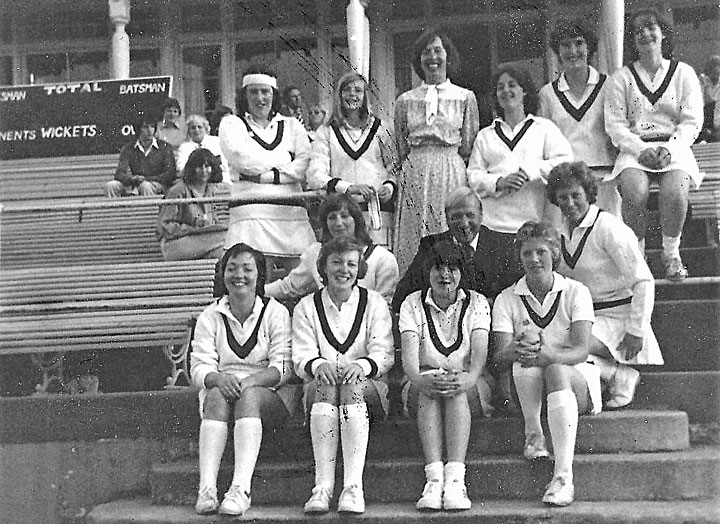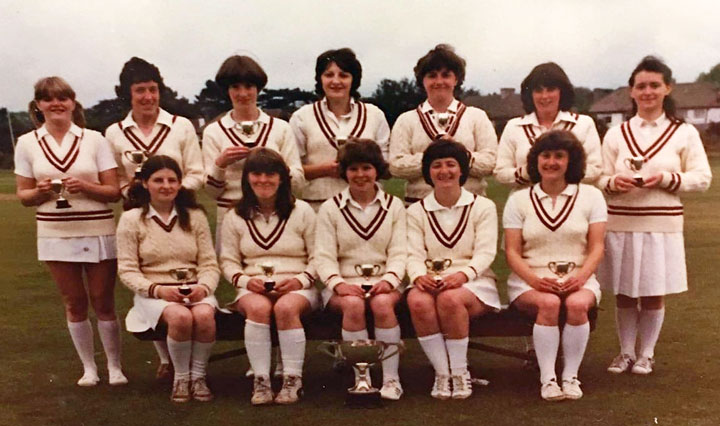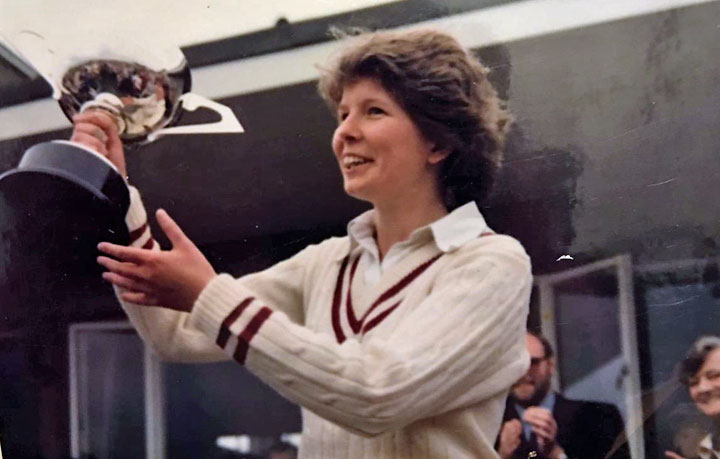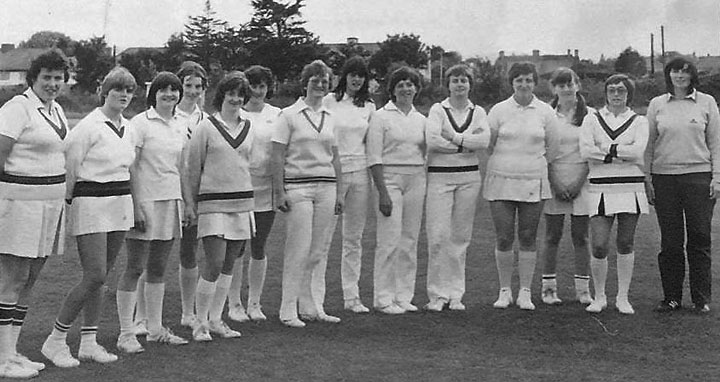I have previously looked at the restart of women’s cricket in Leinster in the late 1970’s, a development largely driven by three women, Clarissa Crawford Pilkington, Isolde Howard and Phyllis Spence. The story was left at the end of the 1977 season with Clontarf the dominant force. What would the next decade bring, would the Northside team still reign or would the spread of the game raise the standard throughout the province.
1978
Any thoughts that the Leinster Women’s Cricket Union had rested on their laurels after such a successful debut season were firmly put to bed when Sean Pender revealed in The Irish Times of 14 May 1978 that visits by Scotland and Yorkshire had been arranged for July and August. Indeed the winter period had been a particularly active one, 64 players had availed of coaching provided by Robin Waters, Ian Cox and Kevin O’Herlihy. Also, Mullingar and Rathdown School had affiliated and strengthened the playing numbers further.
Clontarf were still a powerful outfit but stuttered at the beginning of the season losing 2 of their first 4 games. Phoenix would win the League winning 8 out of 10 of their games with Mary Pat Moore the star with the ball and being the top bowler of the season taking 36 wickets at an average of only 4. One of the games that Phoenix lost was to the Clontarf side that were bowled out for a mere 42 with Mary Pat taking 4 for 15. However in reply they could only manage 40 with inevitably Stella Owens and Marie Coffey doing most of the damage.
Mary Pat Moore had only begun to play cricket in 1978. Her brothers were keen but her initial interest was as a result of her reading their cricket books. Inevitably she would also be drawn into their games too, but it was the visit of the 1977 Australians to Rathmines to play Ireland that captured her imagination. Then, a friend spotted an advertisement for winter nets in early 1978 in Belvedere College and from the start she was hooked. In her early years, she was a fast bowler who batted a bit; indeed Michael Halliday recalls her putting the frighteners on some male players when he included her in a friendly game.
In later years, it was for her batting that she became renowned and while stats do not always give an ideal reflection, in this case they are spot on. She credits the influence of Noel Mahony on not just her cricket but many others too. In the course of the research for this article, Noel’s name keeps cropping up in player’s recollections, his attention to detail and general popularity. Her Irish career ran from 1983 to 1996, despite living in England from 1986 where she also played for Yorkshire. She is recognised as one of the finest bats in Irish Women’s cricket.
Phoenix was far from a one player team however, Wendy Blennerhasset and Sonia Reamsbottom, who would later play State cricket in Australia, were hugely influential on the pitch.
The Tyler Cup final was contested by holders Clontarf and Pembroke, for whom still familiar names Judy Cohen and Mary Sharp starred. The cup was retained by the Northsiders with Mary Hackett and Mary Murray leading a powerful batting performance and Marie Coffey the hero with the ball. Coffey was perhaps a little conflicted as she was President of the LWCU for the year.
Isolde Howard was extremely well thought of in English cricket circles and as a result an invitation was received to send 2 players to the British Annual Week of Cricket Festival which was held in Birmingham. The two selected for this trip on this occasion were Alice Stanton (Merrion) and Grainne Clancy (Kings Hospital and Phoenix) who both acquitted themselves very well in a very high standard of cricket. Both were still young but such was their ability that they were competing at the highest level. Stanton would win the batting cup this year with an average of 85.
Scotland’s mini tour to Dublin consisted of three games v North Leinster, South Leinster and Leinster. There were 3 home wins, with high quality performances coming from Mary Hackett, Alice Stanton, Marie Stanton, Grainne Clancy, Mary Pat Moore and Mary Kenny during the series. These games undoubtedly provided a fillip for the home players and gave an indication of the potential in the province.
1979
It has been previously noted that the Leinster Women’s Cricket Union were particularly adept at playing the Public Relations game and early 1979 gave even more evidence of this gift. An Irishman’s Diary is a hugely popular and influential daily piece on the editorial page of The Irish Times so when an interview with Barbara Schmidt appeared in April it was quite a thing. Barbara Schmidt along with Jenny Halliday had organised a women’s cricket match in Trinity Week in 1975, an event that had created the spark for women’s cricket in Leinster. She handled PR for the LWCU. While the tone of the article borders on the patronising nonetheless it was quite a coup.
On the field there was even more progress. While Clontarf got back to winning ways in the league, they lost their grip on the Tyler Cup. Matched against Merrion who had home advantage in the final, it was a Stanton who again led the way, only this time it was Alice’s sister Marie, whose 56 not out guided Merrion to a 5 wicket win, a win which came off the penultimate ball. Merrion was progressing fast, not just the Stanton sisters but off spinner Rachel Hardiman was quickly marked out as a talent.
The major development that 1979 brought was the exposure to a higher level of standard. In July, Riverside Ladies CC came to Dublin for a series of games against North and South Leinster and a Leinster XI. Riverside were a London club who were English champions in 1978, indeed they were a hugely successful club and had toured in Ireland in the 1950s.
The visitors beat North and South Leinster sides but in the combined team they met their match. The Merrion trio, Marie (55) Alice (44) and Rachel (4 for 28) together with Clontarf’s Stella Owens (4 for 72) saw Leinster victors by 4 wickets. The Leinster team was Kay Lambert (CCC) capt, Colette Branagan (LCC) Grainne Clancy (KH and Phoenix) Rachel Hardiman (MCC) Mary Kenny (LCC) Mary Pat Moore (PCC) Annie Murray (CCC) Alice Stanton (MCC) Marie Stanton (MCC) Stella Owens (CCC) Mary Taaffe (CCC).
The same weekend, a Rest of Leinster side, captained by Linda Murray (Mullingar) played against Railway Union as part of their 75th anniversary celebrations.
While it was wonderful that teams considered touring Ireland, it is also important that teams go away on tour. In August, Clontarf travelled to Edinburgh to take part in what was billed the “First Women’s Cricket Festival”. The other participants were Scotland North, Scotland South and Yorkshire XI. Yorkshire would play against a combined Scotland (6 players) and Clontarf (5) team, described as a Festival XI, on the final day while the two Scottish sides would combine to play against Clontarf. Games were played at the University Ground and The Grange and were 30 overs a side (other than the final Festival XI v Yorkshire game which was 50 overs a side). Clontarf beat South and lost to the North.
 Clontarf in Scotland 1979
Clontarf in Scotland 1979
If the aim of the tour was exposure to a higher standard, it had to be viewed as a great success, included in the Yorkshire side were Sue Hilliam who had played in the England World Cup team of 1973 and Julia Greenwood who in June of the same year had taken 5 for 43 in a test match against the West Indies. We have not been able to establish the other results but we know that the trip was a huge success both on and off the field, particularly off the field we understand!
Helen McDonnell, Judy Cohen and Caroline Watson (from Cork) made the journey this year to the Cricket Week in England. The quality of cricket in this year again was extremely high, with the legendary Rachel Heyhoe-Flint playing in one of the 7 teams at the competition. It was a huge occasion and undoubtedly one that resonated with the young players.
1980
The 1980 season was the year that saw a big push in representative cricket in Leinster. A series of North Leinster v South Leinster games were played. Also, contact was established with the Ulster women’s cricketers and two games were played, the first in May was a Leinster and Ulster “selections” while in later August and full interprovincial game was played. In the first game played in Rush, Ulster were comfortable winners by 6 wickets with Pat Trohear seeing them home with 23 not out in chasing down Leinster’s 54 for 8.
Another interesting representative fixture was a North Leinster v South Leinster schoolgirl’s fixture. This resulted in a win for the Northside team who posted 122 for 8 with Imelda Lambkin of Santa Sabina top scoring with 39. High School’s Gwen Smith took 3 for 35 for the Southern side. In reply, South Leinster could only manage 81 all out with Hold Faith’s Elizabeth (Lilly) Owens doing most of the damage with an impressive 7 for 33. Leinster and Irish cricket would see a lot more of Lilly, the elder sister of Stella Owens, in the coming years.
Clontarf’s Pernod sponsored 6 a side competition continued in popularity, Phoenix beat Leinster (who had won the previous 2 year’s competitions), but Leinster had their eye on a bigger prize in 1980. Leinster had embraced women’s cricket from the start, many of the players had family connections, and familiar names such as Kenny, McDonnell, Delany ran through the team sheet. But as with many other clubs there was a strong hockey connection through Muckross and Old Alex and of course the tennis section provided extremely capable sportswomen.
 1980: Leinster win the cup
1980: Leinster win the cup
Although Clontarf were dominant in the early years, Leinster grew in strength and experience and by 1980 were a force to be reckoned with. They reached their first Tyler Cup final that year, having beaten Clontarf in the first round. In the decider they were up against Phoenix and it was a powerful display from Leinster on the day. Bowling first they restricted Phoenix to 68 for 8 with Catherine McDonnell taking 5 for 30 and Mary Kenny taking the other 3 to fall for just 29 runs. Paula Jones saw them home with 37 not out as they won their first title by 8 wickets.
 Leinster captain Linda Cassidy holds the cup aloft
Leinster captain Linda Cassidy holds the cup aloft
Turning to the North v South Leinster games. We have no card for the game in June but in August a further game took place in Sandford Park School. Batting first South scored 144 with Marie Stanton scoring 46 and Hillary O’Reilly of Railway Union contributing 37. Phoenix bowlers Mary Pat Moore and Grainne Clancy took 4 and 3 wickets respectively. The North managed 126 in response with Moore top scoring in making 35 and Clontarf’s Mary Hackett 28.
Later in August the full Leinster side travelled to Belfast at Stranmillis College grounds had a close win over Ulster. Leinster made only 73 with Leinster’s Colette Branagan making 22. The Leinster bowlers were able to defend their score by restricting Ulster to 63 for 3 in their 30 overs. Donna Armstrong who would give fantastic service to Ulster was their top scorer, also scoring 22 not out.
In the league, Clontarf once again took the title, emphasising their strength in depth over the course of a season.
An interesting side note to this season was the award for the outstanding wicketkeeper. That went to Helen McDonnell from Leinster. Incredibly, she won it for the next four years as well but temporarily let it out of her grasp for a couple of years before reclaiming it in 1987 and 1988. But do not think that this was an uncompetitive discipline, many fine wicket keepers played across the province not least Kay Lambert (Bergin) from Clontarf.
1981
By 1981, women’s cricket was well established in the province. Leagues and cups for each division (two at this stage) and a growing number of players. Development continued beyond the domestic leagues however. In this year a full interprovincial series began, a sponsor was found and the Tetra Pak Cup began. A prize of £100 was on offer for the first winner. North Leinster was the dominant team, remarkably fielding a team consisting of 7 Clontarf players and 4 from Phoenix. But they did not have it all their own way.
The format allowed for the drawn game and in their first outing against Ulster played in Castle Avenue, the visitors pushed them to the wire before a wicket with the second last ball from Mary Pat Moore secured victory. Their game against South Leinster was no less thrilling. Defending 111 they were pushed all the way before bowling the Southsiders out for 109. Ulster secured their first victory in the competition beating newcomers Munster with Donna Armstrong and Pat Trohear both scoring 80s.
Another interesting development was the North v South Leinster B fixture a game won easily by the South Leinster side.
It was the year of the thriller. The Tyler Cup saw Leinster take on Clontarf in the final having beaten Pembroke and Railway Union respectively. And what a game it was. Batting first Clontarf was soon in trouble at 7 for 2 with Annie Murray and Stella Owens gone. Mary Hackett reined in her natural instincts to anchor the innings in top scoring with 29, useful contributions from Mary Taaffe and Lilly Owens brought the score at the game’s half way stage to 84 for 9. The major reason for Clontarf’s difficulties was another outstanding bowling performance from Catherine McDonnell who took 5 for 25 in her 13 overs. Mary Kenny chipped in with 2 wickets.
Leinster must have been delighted but they knew that Clontarf would not go down without a fight and in the Owens sisters they still had formidable challenge to face. The response was built round number 3 batswoman Colette Branagan who top scored with 27 but it took a crucial 7th wicket partnership between captain Linda Cassidy and schoolgirl Gwen Smith to bring the game to the final two overs with 8 still needed. Needing 3 off the final over and 1 off the last ball, Catherine McDonnell was run out leaving the scores level. Cue a scramble for the competition rules before Leinster were declared the winners having lost 8 wickets to Clontarf’s 9. Leinster therefore retained the cup.
In the league, Clontarf won their third consecutive title.
Touring had become a regular feature of the season and 1981 was no different. It was indeed a landmark year as a 14 strong Leinster squad undertook a tour to England to play Young England and Riverside CC in two games each. The Leinster squad was captained by Hilary O’Reilly who joined two club mates in captaining representative sides, Sharon Molins who captained the South Leinster side and Ginger O’Brien who was captaining the Irish men’s team. The other selected players were: Colette Branagan, Paula Jones, Catherine McDonnell, Helen McDonnell (all Leinster) Rachel Hardiman, Karen Smyth and Marie Stanton (all Merrion), Mary Hackett, Annie Murray, Stella Owens (all Clontarf) Grainne Clancy, Mary Pat Moore (all Phoenix) and Marguerite Barry (CYM). The side was managed by Mary Sharpe.
 The Leinster squad that toured England in 1981
The Leinster squad that toured England in 1981
The trips began with the games against Young England and were played in Lancaster University. One both occasions the home side batted first and on both occasions batted for the vast majority of overs. In game 1 they scored 106 for 2 in 39 overs. This left just 23 overs for the Leinster side in which they made 79 for 6 with Marie Stanton making 30. Game 2 took a similar pattern the Young Englanders making 115 all out in 38 overs leaving 24 overs for the visitors who made 66 for 4. The game was notable for an outstanding individual performance by Stella Owens who followed up her 5 for 52 in the first innings with an unbeaten 40 in the second.
The touring party then moved down to London to play Riverside CC. England was buzzing in July 1981, Ian Botham was lifting the nation on the cricket field but in London the talk of the town was the wedding of Prince Charles and Lady Diana Spencer. The hosts normally played in a public park but fears that the parks would be closed due to the wedding meant that the games were moved to Uxbridge CC which was an out ground for Middlesex CCC. In contrast to the earlier games, the visitors batted first on both occasions, losing the first by 9 wickets despite good batting from Mary Hackett (37) and Marie Stanton (36). The second game resulted in a draw after Leinster made 106 all out (Mary Pat Moore 35) but excellent bowling from Rachel Hardiman 4 for 27) restricted the hosts to 84 for 5. While the scores in these games appear low, one of the party recalls the huge boundaries, something that they were not used to in their domestic game.
It is clear that women’s cricket had moved on enormously since its restart and at remarkable pace. But there was more to come as the game moved beyond the confines of Leinster and took hold throughout the island. Those who had rekindled the interest had their eye on a bigger prize and their ambitions were to place women’s cricket on a national stage. The rest of the 80s would be interesting.
This article does not intend to be definitive. It has been compiled though the thanks to the records of Phyllis Spence together with a trawl of newspaper archives, Cricket Leinster’s 100 Not out and various LCU publications of the era. Additionally and most importantly, huge thanks to a number of players of their era who have shared their recollections and photos albums. Particular thanks to Colette Branagan, Kay Bergin, Helen Hearnden (McDonnell), Mary Murray, Mary Pat Moore, Aideen Rice and the wider Spence family. The fondness, with which the era is remembered, makes me think a reunion would be a fantastic affair.
